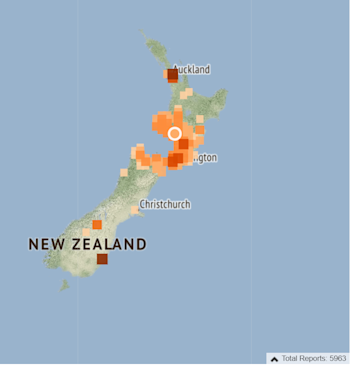
Whanganui Earthquake Q & A
After last night's quake we thought we'd answer some of your questions about what happened and give an explanation for the multiple reported quakes.
Wednesday night’s magnitude 4.7 quake centred just north of Whanganui has raised some questions from the public about the difference between ghost quakes and simultaneous quakes.
On Wednesday night there were two near-simultaneous quakes and this initially confused our automatic quake location system which briefly gave an incorrect location for the Whanganui quake.
We decided to ask GNS Science Duty Seismologist Dr Matt Gerstenberger to walk us through Wednesday night’s events and explain the difference between ghost quakes and simultaneous quakes.
Q 1: How soon after the event struck did you realise that this was not a single quake?
Matt Gerstenberger: We knew almost immediately that two quakes had occurred at the same time and their seismic waves had got tangled up and confused our system which does automatic quake locations. It took us a few minutes to separate the data and confirm correct locations and magnitudes for each quake. Initially our system gave an automatic location of Ruatoria. We could see fairly early on that this could not be correct because our instrument network was showing the strongest shaking in the lower North Island. This was also backed up by the felt reports that people were filing on the GeoNet website. Almost 6,000 people sent in felt reports for this quake.
Q 2: So what were the two quakes?
MG: There was a M5.0 quake in the Kermadec region about 600km northeast of East Cape and the M4.7 quake centred just north of Whanganui at a depth of 96km. The Kermadec quake occurred three minutes before the Whanganui quake, but the seismic waves from both quakes arrived at the same time at many of our stations throughout the country. This is what caused the initial confusion. When we eventually pinned down the magnitude of the Kermadec quake at M5.0, we realised it was too small to be a tsunami threat and we focused exclusively on the Whanganui quake. Like everyone else, we were relieved that the shaking from the Whanganui quake was not strong enough to cause any serious damage. People didn’t feel the offshore quake. The only quake they felt was the one in Whanganui.
Q 3: Does this show that there is a deficiency in New Zealand’s national seismic network, which is a land-based network?
MG: No. The national network is very good at doing the job it was designed for, which is providing us with fast and accurate information on land-based earthquakes. Maybe two or three times a year we get simultaneous quakes that require some additional work to separate. New Zealand gets 20,000-plus quakes each year on average, so it’s inevitable there will be occasional quake combos that need a bit of extra attention to separate.
Q 4: How do simultaneous quakes differ from ghost quakes?
MG: Simultaneous quakes are two or more quakes that occur at the same time. Ghost quakes that show up in our system are usually a single quake and they typically occur offshore, commonly in the Kermadec region. Our seismic network is designed to measure on-land quakes. When seismic waves from a distant, offshore quake arrive at our on-land instruments, our automated system tries to place the earthquake somewhere on land. This can produce a false result which is quickly rectified by the duty seismologist who reviews these automatic locations to make sure they are correct. The US Geological Survey operates a worldwide network which is good at measuring distant and offshore quakes. For such earthquakes outside of our network, we compare our location and magnitude to that of the USGS because of the different information provided by their worldwide coverage. Locating quakes outside New Zealand and working out their depth and magnitude nearly always means using data from international earthquake networks. This process can take longer than confirming the details of on-land quakes.
Science contact - Dr Matt Gerstenberger Media enquiries - media@gns.cri.nz or 021 574 541


